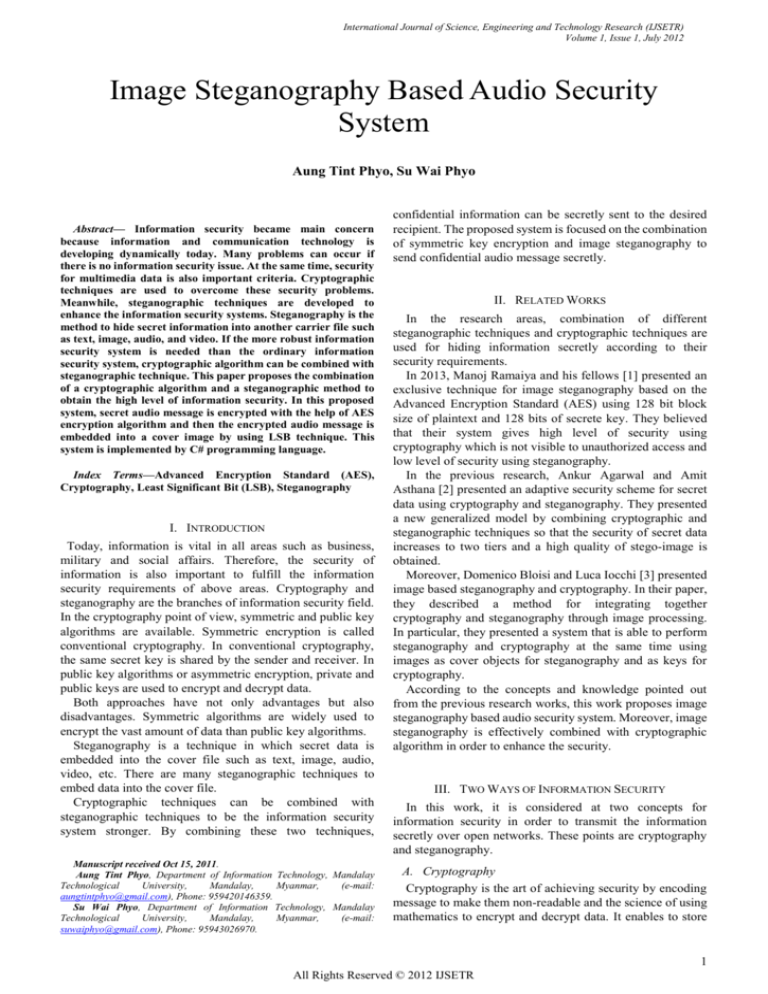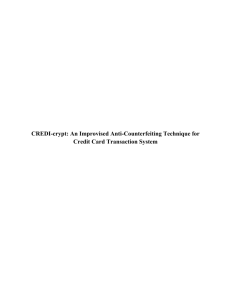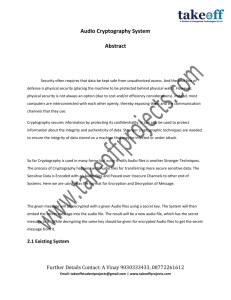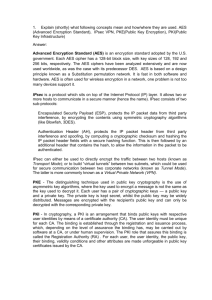
International Journal of Science, Engineering and Technology Research (IJSETR)
Volume 1, Issue 1, July 2012
Image Steganography Based Audio Security
System
Aung Tint Phyo, Su Wai Phyo
Abstract— Information security became main concern
because information and communication technology is
developing dynamically today. Many problems can occur if
there is no information security issue. At the same time, security
for multimedia data is also important criteria. Cryptographic
techniques are used to overcome these security problems.
Meanwhile, steganographic techniques are developed to
enhance the information security systems. Steganography is the
method to hide secret information into another carrier file such
as text, image, audio, and video. If the more robust information
security system is needed than the ordinary information
security system, cryptographic algorithm can be combined with
steganographic technique. This paper proposes the combination
of a cryptographic algorithm and a steganographic method to
obtain the high level of information security. In this proposed
system, secret audio message is encrypted with the help of AES
encryption algorithm and then the encrypted audio message is
embedded into a cover image by using LSB technique. This
system is implemented by C# programming language.
Index Terms—Advanced Encryption Standard (AES),
Cryptography, Least Significant Bit (LSB), Steganography
I. INTRODUCTION
Today, information is vital in all areas such as business,
military and social affairs. Therefore, the security of
information is also important to fulfill the information
security requirements of above areas. Cryptography and
steganography are the branches of information security field.
In the cryptography point of view, symmetric and public key
algorithms are available. Symmetric encryption is called
conventional cryptography. In conventional cryptography,
the same secret key is shared by the sender and receiver. In
public key algorithms or asymmetric encryption, private and
public keys are used to encrypt and decrypt data.
Both approaches have not only advantages but also
disadvantages. Symmetric algorithms are widely used to
encrypt the vast amount of data than public key algorithms.
Steganography is a technique in which secret data is
embedded into the cover file such as text, image, audio,
video, etc. There are many steganographic techniques to
embed data into the cover file.
Cryptographic techniques can be combined with
steganographic techniques to be the information security
system stronger. By combining these two techniques,
Manuscript received Oct 15, 2011.
Aung Tint Phyo, Department of Information Technology, Mandalay
Technological
University,
Mandalay,
Myanmar,
(e-mail:
aungtintphyo@gmail.com), Phone: 959420146359.
Su Wai Phyo, Department of Information Technology, Mandalay
Technological
University,
Mandalay,
Myanmar,
(e-mail:
suwaiphyo@gmail.com), Phone: 95943026970.
confidential information can be secretly sent to the desired
recipient. The proposed system is focused on the combination
of symmetric key encryption and image steganography to
send confidential audio message secretly.
II. RELATED WORKS
In the research areas, combination of different
steganographic techniques and cryptographic techniques are
used for hiding information secretly according to their
security requirements.
In 2013, Manoj Ramaiya and his fellows [1] presented an
exclusive technique for image steganography based on the
Advanced Encryption Standard (AES) using 128 bit block
size of plaintext and 128 bits of secrete key. They believed
that their system gives high level of security using
cryptography which is not visible to unauthorized access and
low level of security using steganography.
In the previous research, Ankur Agarwal and Amit
Asthana [2] presented an adaptive security scheme for secret
data using cryptography and steganography. They presented
a new generalized model by combining cryptographic and
steganographic techniques so that the security of secret data
increases to two tiers and a high quality of stego-image is
obtained.
Moreover, Domenico Bloisi and Luca Iocchi [3] presented
image based steganography and cryptography. In their paper,
they described a method for integrating together
cryptography and steganography through image processing.
In particular, they presented a system that is able to perform
steganography and cryptography at the same time using
images as cover objects for steganography and as keys for
cryptography.
According to the concepts and knowledge pointed out
from the previous research works, this work proposes image
steganography based audio security system. Moreover, image
steganography is effectively combined with cryptographic
algorithm in order to enhance the security.
III. TWO WAYS OF INFORMATION SECURITY
In this work, it is considered at two concepts for
information security in order to transmit the information
secretly over open networks. These points are cryptography
and steganography.
A. Cryptography
Cryptography is the art of achieving security by encoding
message to make them non-readable and the science of using
mathematics to encrypt and decrypt data. It enables to store
1
All Rights Reserved © 2012 IJSETR
International Journal of Science, Engineering and Technology Research (IJSETR)
Volume 1, Issue 1, July 2012
sensitive information or transmit it across insecure networks
(like the internet) so that it cannot be read by anyone except
the intended recipient [4]. The security goals to meet the
security requirements are:
Confidentiality means that unauthorized parties cannot
access information.
Authenticity refers to validating the source of the message to
ensure the sender is properly identified.
Integrity provides assurance that the message was not
modified during transmission, accidentally or intentionally.
Non-repudiation means that a sender cannot deny sending
the message at a later date, and the receiver cannot deny
receiving it [5].
In cryptography, encryption algorithms can be categorized
into symmetric key (private) and asymmetric (public) key
[6].
Receiver
Sender
Shared secret key
Plaintext (P)
Plaintext (P)
Encryption (E)
Decryption (D)
Ciphertext
Figure 1. Schematic diagram of symmetric cryptosystem
With symmetric encryption, confidentiality is guaranteed
by the use of a secret key as shown in Figure 1. To achieve
confidentiality, symmetric cryptographic algorithms are
used.
Alice
Bob
Plaintext (P)
Alice’s private
key
Alice’s public
key
Encryption (E)
Ciphertext
Figure 3. Types of steganography
Among those various carrier media, image steganography
is very popular to hide information in it. In this proposed
system, image steganography is used to hide secret audio file.
LSB (Least Significant Bit) algorithm is used in this proposed
system.
IV. BACKGROUND THEORIES OF PROPOSED SYSTEM
To develop the proposed system, cryptographic symmetric
encryption algorithm; Advanced Encryption Standard (AES)
is used for data encryption. To create image steganography,
Least Significant Bit (LSB) method is used to hide the
encrypted data into the cover image file.
A. Advanced Encryption Standard (AES)
AES is Advanced Encryption Standard, a United States
government standard algorithm for encryption and
decryption data. AES is a symmetric block cipher with a
block size of 128 bits. This means that it uses the same key
for both encryption and decryption. AES Key lengths can be
128 bits, 192 bits, or 256 bits; called AES-128, AES-192 and
AES-256, respectively. AES-128 uses 10 rounds, AES-192
uses 12 rounds and AES-256 uses 14 rounds. The rounds
operate on two 128-bit inputs: “State” and “Round key” [9].
Plaintext (P)
Decryption (D)
Figure 2. Schematic diagram of asymmetric cryptosystem
Public-key cryptography solves the key-distribution
problem by making a scheme that uses two keys, public key
and private key, rather than one [7]. It uses a pair of keys: one
that encrypts the data and one that decrypts the data as shown
in Figure 2. It is also called public key cryptosystems.
In these two types of encryption techniques, symmetric
cryptographic systems are popular for high speed encryption
and low cipher expansion rate, comparing to asymmetric
cryptosystems. The proposed system uses Advanced
Encryption Standard (AES), the symmetric encryption
algorithm.
B. Steganography
Steganography is the art of hiding information and an
effort to conceal the existence of the embedded information
[8]. The term steganography is derived from the Greek word
“stegano” means “covered” and “graphy” means “writing”.
The goal of steganography is to hide message inside other
harmless message in a way that does not allow any enemy to
even detect that there is a second secret message present [8].
It includes a vast array of secret communications methods
that conceal the message’s existence. Most of steganography
works have been carried out on image, video, audio and text
as shown in Figure 3.
Types of
Steganography
2
All Rights Reserved © 2012 IJSETR
International Journal of Science, Engineering and Technology Research (IJSETR)
Volume 1, Issue 1, July 2012
Plaintext
Add Round Key
Round 1
Substitute bytes
Mix columns
..
.
Plai
w[0,3]
Add Ro
Expand Keys
InverseR
Inverse mi
w[4,7]
Add Ro
Inverse
Substitute bytes
Round 9
Key
Shift rows
_ _ _ _ _ _ _ _ _ _ _ _ _ _ _ _ _ _ _ _ _ _ _ _ _ _ _ _ _ _ _ _ _Inverse
____
Add Round Key
Shift rows
Mix columns
Add Round Key
Round 10
Inverse MixColumns( )
Again, the tenth round simply leaves out the Inverse
MixColumns stage [10]. Each of these stages is in more detail
as shown in Figure 4.
SubBytes( ) adds confusion by processing each byte
through an S-Box. An S-Box is a substitution table, where
one byte is substitution algorithm.
ShiftRows( ) provides diffusion by mixing data within
rows. Row zero of the State is not shifted, row 1 is 1 byte, row
2 is shifted 2 bytes and row 3 is shifted 3 bytes.
MixColumns( ) also provides diffusion by mixing data
within columns. The 4 bytes of each column in the State are
treated as a 4-byte number and transformed to another 4-byte
number via finite field mathematics.
AddRoundKey( ) performs the actual ‘encryption’, when
each bytes in the State is XORed with the sub key. The
subkey is derived from the key according to a key expansion
schedule.
AES key Expansion( ) The AES key expansion algorithm
takes input a 4-word (16-bytes) key and produces a linear
array of 44 words, providing a 4-word round key for initial
AddRoundKey stage and each of the 10 rounds of the cipher
[1].
Substitute bytes
Shift rows
Add Round Key
Ciphertext
Figure 4. The overall structure of the AES algorithm
(a) Encryption
These operate on a 4x4 arrays of bytes, termed the state.
The proposed system used 128 bits and 128 bits key size. For
complete encryption, the data is passed through 10 rounds.
The algorithm begins with AddRoundKey stage followed by
9 rounds of four stages and a tenth round of three stages. This
applies for both encryption and decryption with the
expansion that each stage of a round the decryption algorithm
is the inverse of its counterpart in the encryption algorithm.
The four stages are as follows:
SubBytes()
ShiftRows()
MixColumns()
AddRoundKey()
The tenth round simply leaves out the Mix Columns stage.
The first nine rounds of the decryption algorithm consist of
the following:
Inverse ShiftRows( )
Inverse SubBytes( )
Inverse AddRoundKey( )
Inverse
B. Least Significant Bit (LSB)
Least Significant Bit (LSB) insertion is a common, simple
approach to embedding information in a cover image. Image
is composed of bits of RGB values. R stands for red, G stand
for green and B stands for blue. After that, the least
significant bit of some or all of the bytes inside an image is
changed to a bit of each of the Red, Green and Blue color
components so that they can be used, since they are each
represented by a byte. In other words one can store 3 bit in
each pixel. An 800*600 pixel image can store a total amount
of 1,440,000 bits or 180,000 bytes of embedded data. For
example a grid for 3 pixels of a 24 bit image can be as
follows:
(00101101 00011100 11011100)
(10100110 11000100 00001100)
(11010010 10101101 01100011)
When the letter A, which binary representation is
01000001 and is embedded into the least significant bits of
this part of the image, the resulting grid is as follows:
(00101100 00011101 11011100)
(10100110 11000100 00001100)
(11010010 10101101 01100011)
Although the letter was embedded into the first 8 bytes of
the grid, only the two highlighted bits need to be changed
according to the embedded message. On average only half of
the bit in an image will need to be modified to hide a secret
message using the maximum cover size.
The proposed system is designed to embed the data
(encrypted audio) into an image. The least significant bit of
each byte of image is substituted by the binary bit of data and
then the stego-image is produced [11].
Inverse mi
w[36,39]
Add Ro
Inverse
Inverse s
w[40,43]
V. PROPOSED SYSTEM DESIGN
The proposed system can be categorized into two portions:
the sender’s view and the receiver’s view as shown in Figure
5 and Figure 6.
3
All Rights Reserved © 2012 IJSETR
Add Ro
Cip
(b)De
International Journal of Science, Engineering and Technology Research (IJSETR)
Volume 1, Issue 1, July 2012
Original
Audio File
Secret
Key
AES
Encrypted
Audio File
Cover
Image
Figure 7. Home interface
LSB
Stego
Image
Figure 5. Block diagram from the sender’s view
The secret audio file is encrypted by AES encryption
algorithm with the help of secret key at the sender’s side.
Then the encrypted audio file is embedded into a cover image
by LSB algorithm and it can produce the stego-image.
The original audio file is encrypted first at the sender’s
side, which is illustrated in Figure 8. In this stage, the user is
needed to load the original audio file and needed to point the
location for the encrypted file. Then the user has to fill the
secret key to encrypt the original file with the help of AES
algorithm. The interface for encryption process is shown in
Figure 8.
Stego
Image
Cover
Image
LSB
Extraction
Encrypted
Audio File
Secret
Key
Figure 8. Encryption interface
The next phase is embedding phase. To do that, encrypted
file has to be embedded into a cover image. The user has to
load the encrypted file and open the cover image. The user
can embed the encrypted file into the cover file by using LSB
algorithm. Then the stego-image is got and the user can save
that image at the desired location. The embedding interface is
shown in Figure 9.
AES
Original
Audio File
Figure 6. Block diagram from the receiver’s view
The encrypted audio file is extracted from the stego-image
by using LSB extraction algorithm at the receiver’s side. The
extracted secret audio file is decrypted by the AES algorithm
with the shared secret key and the original audio file is then
produced.
VI. IMPLEMENTATION OF PROPOSED SYSTEM
Implementation results are described in this section and
these are presented as a series of interfaces. The ‘Home’
interface is illustrated in Figure 7.
.
Figure 9. Embedding interface
4
All Rights Reserved © 2012 IJSETR
International Journal of Science, Engineering and Technology Research (IJSETR)
Volume 1, Issue 1, July 2012
author would like to express his heartfelt gratitude to his
supervisor Dr. Su Wai Phyo, Associate Professor,
Department of Information Technology, Mandalay
Technological University, for her kind advice, permission
and supervision. Finally, the author would like to thank to his
parents and family members for their supports and
encouragements.
REFERENCES
[1]
Figure 10. Extraction interface
The user must extract the encrypted file first from the
stego-image at the receiver’s side. At the extraction interface,
the user has to load the stego-image and has to choose the
location to save extracted file. Then, the user can extract the
encrypted file from the stego-image as illustrated in Figure
10.
Manoj Ramaiya, Naveen Hemrajani and Anil Kishore Saxena,
“Secured Steranography Approach Using AES”, International Journal
of Computer Science Engineering and Information Technology
Research (IJCSEITR) ISSN 2249-6831, Vol.3, Issue 3, Aug 2013,
185-192 © TJPRC Pvt.Ltd.
[2] Ankur Agarwal and Amit Asthana, “An Adaptive Security Scheme for
Secret Data Using Cryptography and Steganography”, 2nd International
Conference on Role of Technology in Nation Building
(ICRTNB-2013), ISBN: 97881925922-1-3, pp. 113-122.
[3] Domenico Bloisi, and Luca Iocchi, “Image Based Steganography and
Cryptography”, IJNCAA, 2009.
[4] Ayushi Lecturer, Sonipat, Haryana, “A Symmetric Key Cryptographic
Algorithm”, ©2010 International Journal of Computer Applications
(0975-8887) Volume 1-No.15.
[5] Chapter 8, Cryptography – CCCure.org, Available Online:
http://www.cccure.org/Documents/Cryptograpgy/cisspallinone.pdf.
[6] Shashi Mehrotra Seth and Rajan Mishra, “Comparative Analysis of
Encryption Algorithms for Data Communication”, MERI College of
Engg. & Tech, India, 2011, ISSN: 0976-8491.
[7] Jon Callas, “An Introduction to Cryptography”, 2009.
[8] K.Yugala, K.Venkata Rao. “Steganography”, International Journal of
Engineering Trends and Technology (IJETT) Vollume4Issue5-May
20.
[9] Israel Shay Gueron, “Advanced Encryption Standard (AES)
Instructions Set”, White Paper, Intel Mobility Israel Development
Center, Israel Shay Gueron.
[10] Chapter 7, The Advanced Encryption Standard (AES), Available
Online: www.facweb.iitkgp.ernet.in./~sourav/AES.pdf.
[11] MrithaRamalingam, “Stegomachine – Video Steganography using
Modified LSB Algorithm”, 2011.
Figure 11. Decryption interface
The user at the receiver’s side must decrypt the extracted
file as illustrated in Figure 11. The user has to load the
extracted file and needs to type the correct 16 digits secret
key.
VII. CONCLUSION
The proposed system uses Advanced Encryption Standard
(AES) algorithm for cryptographic portion and Least
Significant Bit (LSB) algorithm for steganographic portion.
Therefore, the proposed system can support two layers of
security. But the weak point of this proposed system is that it
can be allowed for small size of audio file (only .amr file
format) to embed into an image (.bmp). The proposed system
can be modified and combined with other cryptographic
algorithms and steganographic techniques to extend more
robust security system as further extension.
ACKNOWLEDGMENT
The author would like to thank Dr. Myint Thein, Rector of
Mandalay Technological University, for his motivation,
supports and guidance. The author is particularly grateful to
Dr. Aung Myint Aye, Associate Professor and Head of
Department of Information Technology, Mandalay
Technological University, for his supports and guidance. The
5
All Rights Reserved © 2012 IJSETR








